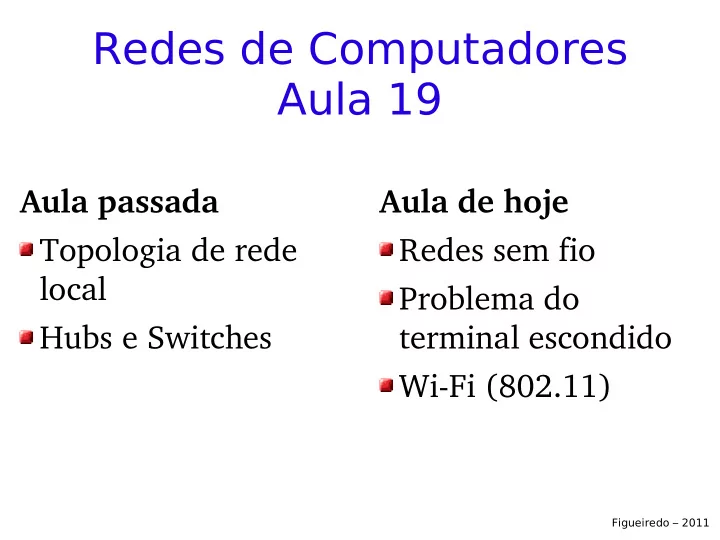

Redes de Computadores Aula 19 Aula passada Aula de hoje Topologia de rede Redes sem fio local Problema do Hubs e Switches terminal escondido Wi-Fi (802.11) Figueiredo – 2011
Elements of a wireless network wireless hosts ❒ laptop, PDA, IP phone ❒ run applications ❒ may be stationary (non- mobile) or mobile ❍ wireless does not network always mean mobility infrastructure Figueiredo – 2011
Elements of a wireless network base station ❒ typically connected to wired network ❒ relay - responsible for sending packets between wired network and wireless network host(s) in its “area” infrastructure ❍ e.g., cell towers, 802.11 access points Figueiredo – 2011
Elements of a wireless network wireless link ❒ typically used to connect mobile(s) to base station ❒ also used as backbone link ❒ multiple access network protocol coordinates infrastructure link access ❒ various data rates, transmission distance Figueiredo – 2011
Elements of a wireless network infrastructure mode ❒ base station connects mobiles into wired network ❒ handoff: mobile changes base station providing connection network into wired network infrastructure Figueiredo – 2011
Wireless Link Characteristics (1) Differences from wired link …. decreased signal strength: radio signal attenuates as it propagates through matter (path loss) interference from other sources: standardized wireless network frequencies (e.g., 2.4 GHz) shared by other devices (e.g., phone); devices (motors) interfere as well multipath propagation: radio signal reflects off objects ground, arriving ad destination at slightly different times …. make communication across (even a point to point) wireless link much more “difficult” Figueiredo – 2011
Wireless Link Characteristics (2) SNR: signal-to-noise ratio 10 -1 larger SNR – easier to extract signal from noise (a “good 10 -2 thing”) 10 -3 SNR versus BER tradeoffs given physical layer: increase BER 10 -4 power -> increase SNR- 10 -5 >decrease BER given SNR: choose physical 10 -6 layer that meets BER requirement, giving highest 10 -7 10 20 30 40 thruput SNR(dB) SNR may change with mobility: dynamically adapt physical layer QAM256 (8 Mbps) (modulation technique, rate) QAM16 (4 Mbps) BPSK (1 Mbps) Figueiredo – 2011
Wireless network characteristics Multiple wireless senders and receivers create additional problems (beyond multiple access): A B C C C’s signal A’s signal strength B strength A space Hidden terminal problem Signal attenuation: ❒ B, A hear each other ❒ B, A hear each other ❒ B, C hear each other ❒ B, C hear each other ❒ A, C can not hear each other ❒ A, C can not hear each other means A, C unaware of their interfering at B interference at B Figueiredo – 2011
IEEE 802.11: multiple access avoid collisions: 2 + nodes transmitting at same time 802.11: CSMA - sense before transmitting don’t collide with ongoing transmission by other node 802.11: no collision detection! difficult to receive (sense collisions) when transmitting due to weak received signals (fading) can’t sense all collisions in any case: hidden terminal, fading goal: avoid collisions: CSMA/C(ollision)A(voidance) B A C C C’s signal A’s signal strength B strength A space Figueiredo – 2011
IEEE 802.11 MAC Protocol: CSMA/CA 802.11 sender 1 if sense channel idle for DIFS then sender receiver transmit entire frame (no CD) 2 if sense channel busy then DIFS start random backoff time timer counts down while channel idle data transmit when timer expires if no ACK, increase random backoff interval, repeat 2 SIFS 802.11 receiver ACK - if frame received OK return ACK after SIFS (ACK needed due to hidden terminal problem) Figueiredo – 2011
Avoiding collisions (more) idea: allow sender to “reserve” channel rather than random access of data frames: avoid collisions of long data frames sender first transmits small request-to-send (RTS) packets to BS using CSMA RTSs may still collide with each other (but they’re short) BS broadcasts clear-to-send CTS in response to RTS CTS heard by all nodes sender transmits data frame other stations defer transmissions avoid data frame collisions completely using small reservation packets! Figueiredo – 2011
Collision Avoidance: RTS-CTS exchange A B AP B ) S ( T R RTS(A) reservation collision RTS(A) C T CTS(A) S ( A ) DATA (A) defer time A ACK(A) C K ( A ) Figueiredo – 2011
Recommend
More recommend